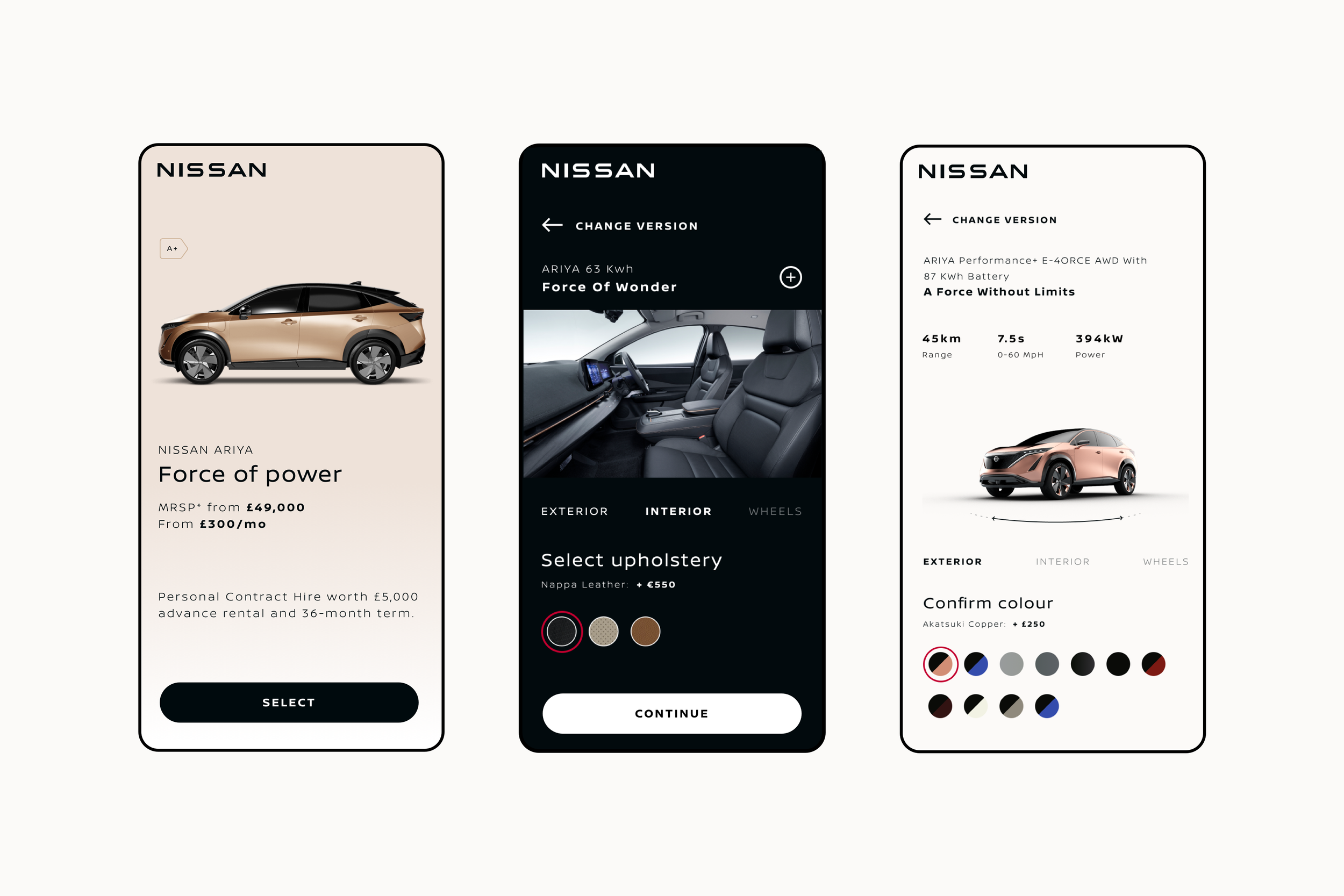Nissan
Scope:
Discovery
Branding
Design System
Strategy
UX
UI
Motion Design
Increasing customer satisfaction scores by 15% for all new experiences
Background:
In July 2020, Nissan unveiled its first new logo in 20 years alongside the launch of the Nissan Ariya, the brand's first all-electric crossover SUV. The digital World Premiere showcased Nissan’s future vision, blending the car launch with the reveal of its new identity to highlight the brand’s shift towards advanced technology and seamless customer experiences. This pivotal moment laid the foundation for creating a Global Design System, connecting Nissan’s heritage with its digital-first future.
Objectives
The primary objective of creating a Global Design System for Nissan was to establish consistency and cohesion across the rapidly expanding global design team. With no unified repository or single source of truth, the lack of knowledge sharing and alignment posed significant challenges to delivering on the brand’s promise.
The design system aimed to go beyond a simple toolkit of reusable elements—it sought to create a meaningful structure that addressed the needs of cross-functional teams while supporting Nissan's latest rebrand. By putting into operation a globally governed system, the goal was to drive efficiency, streamline design processes, and unlock business value for internal and external teams alike.




Experience principles
Working closely with the Nissan brand team, we created an experience framework; defining experience principles and design pillars to hang all our thinking from. Every detail, whether a small icon or a large screen transition, needed to tie back to the pillars ensuring a consistent visual language that could scale across all digital experiences.


Design System
To ensure consistency for customers, as well as efficiency in the experience creation, we created The Nissan Next Design System. A universal visual language shaping all digital products with the aim to empower Nissan to further transition into modern innovation practices.
Working closely with Nissan we reimagined, defined and executed a global rollout plan for a unique and distinct brand experience across touchpoints. This included working directly with other external agencies and partners.


Motion Principles
As part of the Design System we built a Motion Framework that aligns with the Nissan Brand Manifesto of ‘Move Beyond’. It’s about finding ways of expression through the UI across every touchpoint that enhances the personality of the brand.
All UI motion mimics the light movement from the vehicle lights. This simple but unifying idea helps to connect the physical car to the screen interactions of Nissan digital product, creating a seamless visual language within the customer experience.
Outcomes
In order to quickly iterate with confidence, design teams need access to a single source of truth that allows for a scalable UI language and streamlined UX guidelines. With brand touchpoints reaching over multiple channels and platforms, consistent user experience can be assisted by leveraging a central design language.
The success of the design system was measured by its adoption rate across global teams, achieving 85% usage within six months. It also reduced design-to-development turnaround times by 30%, streamlining processes and increasing efficiency across cross-functional teams. Other key metrics include:
Faster Approvals:
Accelerated approval timelines for new experiences by 25%, thanks to improved cross-functional collaboration.
Reusable Assets:
Improved team efficiency with a 30% increase in productivity, leveraging a library of reusable design assets.
Accelerated Market Entry:
Enabled faster speed-to-market for new applications, reducing launch timelines by 30%.
Lower Support Requests:
Reduced support requests for CX, design, and IT teams by 25% through the implementation of a self-serve system.
Enhanced Team Productivity:
Boosted designer and developer productivity by 20% through the use of streamlined processes and reusable components.
Customer Satisfaction:
Increased customer satisfaction scores by 15%, driven by consistent and high-quality digital experiences.
Reduced Customer Support Requests:
Lowered customer support requests by 10%, ensuring a more seamless and intuitive user experience.
Customer Engagement and Loyalty:
Boosted customer engagement and loyalty by 18%, reflecting improved brand consistency and user-centric design.
Streamlined Onboarding:
Decreased onboarding time for new hires, vendors, and partners by 40%, enabling quicker alignment with design and development workflows.
Reduced QA and Development Wastage:
Minimised QA efforts and reduced development wastage by 15% due to standardised components and guidelines."
Project Details -
Jude Gay - Creative Director
Daniele Signorello - UI Lead
Rebecca Werres - Senior Design
Harpreet Kaloty - Design Lead
Dipanjan Biswas - Design System
Sandeep Singh Bisran - UX Lead
Phil Young - Senior UX Architect
Adam Ryan - Product Owner
Team
The Role
Company:
PublicisSapient
Year:
2020-2021
Role:
Design Lead
Project:
Brand Identity & Design System













